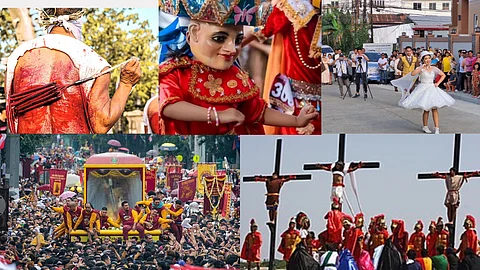
- NEWS
- the EDIT
- COMMENTARY
- BUSINESS
- LIFE
- SHOW
- ACTION
- GLOBAL GOALS
- SNAPS
- DYARYO TIRADA
- MORE

As the Lenten season unfolds each year, the Philippines transforms into a living tableau of faith, sacrifice, and cultural heritage. Holy Week, or Semana Santa, remains one of the most solemn and deeply revered observances in the country — an intersection of Catholic devotion and age-old folk traditions passed down through generations.
Beyond church rituals and private reflection, many Filipino communities mark this sacred time with unique local practices that blend faith, performance, and history. Here are five of the most distinct Holy Week traditions that reflect the colorful and spiritual soul of the Filipino people.
Marinduque’s famed Moriones Festival is arguably one of the most iconic Holy Week celebrations in the country.
Stretching from Holy Monday to Easter Sunday, this weeklong religious folk festival transforms the towns of Boac, Gasan, Mogpog, and others into a vibrant stage for a moving street drama. Men and women dressed as Roman soldiers — known as Morions — parade through the streets, reenacting the story of Saint Longinus, a blind centurion whose sight was miraculously restored after witnessing Christ's crucifixion.
Wearing elaborately painted masks and 16th-century-inspired helmets, these participants embody both penitence and performance, blending Catholic storytelling with cultural pageantry.
In the province of Pampanga, devotion takes a more intense form. Here, two major traditions define the Lenten experience: the puni and the magdarame.
Puni refers to temporary shrines erected in communities where residents gather to chant the pabasa, a marathon recitation of the Passion of Christ in Filipino verse.
But it’s the presence of the magdarame—penitents who voluntarily undergo acts of physical suffering—that draws both awe and debate. Whether it’s flagellants whipping their backs, cross-bearers trudging silently through towns, or even those who are nailed to crosses in places like San Pedro Cutud, these acts are seen by practitioners as intense forms of penance and spiritual cleansing. Despite controversy and warnings from religious leaders, the tradition remains deeply embedded in the Kapampangan psyche, passed down through generations as a form of inherited faith and devotion.
Quiapo, Manila’s religious heart, becomes even more intense during Holy Week. While the annual Traslacion of the Black Nazarene in January draws millions, the devotion doesn’t pause during Semana Santa. The faithful gather as early as Palm Sunday in Plaza Miranda, reenacting Christ’s triumphant entry into Jerusalem with blessed palms, chants, and prayers.
Throughout the week, Quiapo sees a continuous stream of devotees engaged in the Pabasa, Senakulo (Passion plays), and Visita Iglesia. A special pre-dawn procession of the Black Nazarene on Good Friday rekindles the immense devotion many feel toward this dark-skinned image of Christ, believed by many to be miraculous.
On the island of Guimaras in Western Visayas, Holy Week takes on a dramatic turn with the annual staging of the Pagtaltal sa Guimaras. This passion play — performed on Good Friday in the town of Jordan — features a large-scale reenactment of the passion and death of Christ, reminiscent of Jerusalem’s Stations of the Cross.
Set against a scenic backdrop of the sea and hills, local actors bring the Biblical narrative to life, culminating in a crucifixion scene atop a hill.
While much of Holy Week is characterized by somber rituals, the town of Ibaan in Batangas brings the season to a close with a joyous celebration.
The Sayaw ng Pagbati (Dance of Greeting) is a tradition performed on Easter Sunday to dramatize the encounter between the risen Christ and His mother, the Virgin Mary.
Dancers, often young girls dressed in white with colorful sashes, perform choreographed movements in the town plaza and church grounds. As they gracefully sway to the tune of religious songs, the mood shifts from mourning to celebration, symbolizing the triumph of life over death. The Sayaw ng Pagbati is a poignant reminder that the sorrow of Good Friday is never the end of the story — it is the prelude to resurrection and hope.
These Holy Week traditions — deeply rooted in regional history and faith — offer a profound glimpse into how Filipinos embody their spirituality. Whether through theatrical reenactments, acts of physical penance, or joyful dances of celebration, each tradition showcases a uniquely Filipino way of commemorating Christ’s passion, death, and resurrection.
